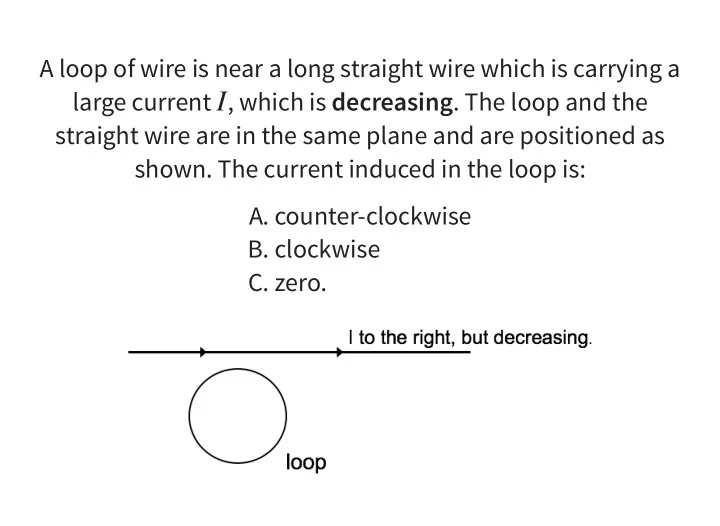

A loop of wire is near a long straight wire which is carrying a large current , which is decreasing . The loop and the I straight wire are in the same plane and are positioned as shown. The current induced in the loop is: A. counter-clockwise B. clockwise C. zero.
The current in an infinite solenoid with uniform magnetic field inside is B increasing so that the magnitude in B increasing with time as . A B = B 0 + kt small circular loop of radius is placed r outside the solenoid as shown. What is the emf around the small loop? (Assume CW is the positive direction of current flow). A. k π r 2 B. − k π r 2 C. Zero D. Nonzero, but need more information for value E. Not enough information to tell if zero or non-zero
The current in an infinite solenoid with uniform magnetic field inside is increasing so that the magnitude in B B increasing with time as . A small circular loop of B = B 0 + kt radius is placed coaxially inside the solenoid as shown. r Without calculating anything, determine the direction of the induced magnetic field created by the induced current in the loop, in the plane region inside the loop? A. Into the screen B. Out of the screen C. CW D. CCW E. Not enough information
The current in an infinite solenoid with uniform magnetic field inside is increasing so that the magnitude B is B increasing with time as . A circular loop of B = B 0 + kt radius is placed coaxially outside the solenoid as shown. In r what direction is the induced field around the loop? E A. CW B. CCW C. The induced E is zero D. Not enough information
The current in an infinite solenoid of radius with uniform R magnetic field inside is increasing so that the magnitude B in increasing with time as . If I calculate B B = B 0 + kt V along path 1 and path 2 between points A and B, do I get the same answer? A. Yes B. No C. Need more information
A long solenoid of cross sectional area, , creates a A magnetic field, that is spatially uniform inside and zero B 0 ( t ) outside the solenoid. SO: A. μ 0 I E = 2 π r B. E = − A ∂ B 1 π r 2 ∂ t C. E = − A 2 π r ∂ B ∂ t D. E = − A ∂ B 1 ∂ t 2 π r
E. Something else If the arrows represent an E field, is the rate of change in magnetic flux (perpendicular to the page) through the dashed region zero or nonzero? A. d Φ = 0 dt B. d Φ ≠ 0 dt C. ???
If the arrows represent an E field (note that |E| is the same everywhere), is the rate of change in magnetic flux (perpendicular to the page) in the dashed region zero or nonzero? A. d Φ = 0 dt B. d Φ ≠ 0 dt C. Need more information
Recommend
More recommend